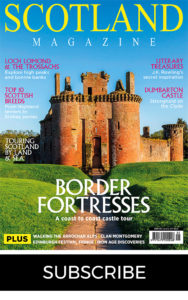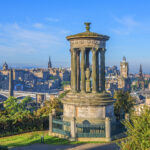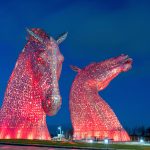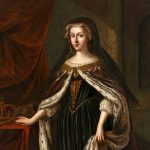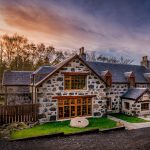MORE FROM SCOTLAND MAGAZINE
Clan castles: Whose clan seat is that?
As part of our clan special, our resident Scottish genealogist brings us 12 of his favourite Scottish clan castles and the clans and families linked to them
Words by Dr Bruce Durie
Dunrobin Castle
Golspie, Dornoch
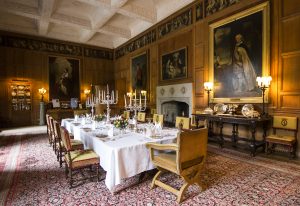
Gordon, Sutherland
Dunrobin is the furthest north of Scotland’s great castles, offering great views over the Moray Firth. With its French-inspired design by Sir Charles Barry – also responsible for London’s Houses of Parliament – dating from 1835-1850, it’s also the embodiment of a fairytale castle.
The interiors of Dunrobin’s 189 rooms were restored after a fire in 1915, courtesy of Scottish architect, Sir Robert Lorimer. Some of the original building can be seen in the interior courtyard.
The Sutherlands, later earls then dukes, have been at Dunrobin Castle since the 14th century, with the land in the hands of Hugh de Moravia, grandson of the Flemish noble Freskin, before 1211. The Earldom of Sutherland was created for Hugh’s son, William, around 1230.
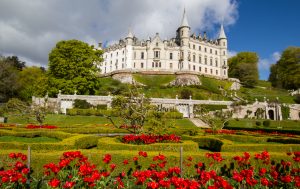
The name, Dunrobin, is said to come from Robert Sutherland, the 6th Earl of Sutherland, who died in 1444. Briefly in the hands of the Gordon Earls of Huntly, in 1518 the castle was taken by the legitimate heir to the Sutherland Earldom, Alexander Sutherland. However, the Gordons subsequently retook it and put Alexander’s head on a spear on top of the castle tower. They also killed his son, John, when he made an attempt on Dunrobin in 1550.
During the 1745 Jacobite Rising, the 17th Earl, who had changed his surname from Gordon to Sutherland, supported the Hanoverians and had to escape through the back door when Charles Edward Stuart’s forces stormed Dunrobin. His granddaughter, Elizabeth, married the politician George Leveson-Gower, later 1st Duke of Sutherland, who altered and extended Dunrobin from 1785, and the pair are controversial figures due to the eviction of thousands of tenants on their land during the Highland Clearances.
Castle Menzies
Weem, near Aberfeldy, Perthshire
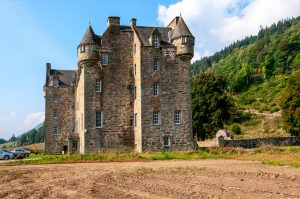
Menzies, MacGregor, Stewart of Cardney
The main thing to remember when visiting Castle Menzies is that it’s pronounced ‘ming-iss’, so it’s worth practising before you arrive.
It’s located in the village of Weem – just north of the Black Watch Museum – and if you’re coming from the south, you’ll see General Wade’s Bridge, which we mentioned last issue. Castle Menzies was the ancestral seat of Clan Menzies and the Menzies Baronets and is located close to the former site of Weem Castle, which was destroyed around 1502.
On your visit, look out for the marriage stone above the original entrance, installed in 1571 by James Menzies upon his marriage to Barbara Stewart, daughter of John Stewart, 3rd Earl of Atholl. Bonnie Prince Charlie, stayed here for two nights while on his way to the disastrous Battle of Culloden in 1746, followed four days later by the Duke of Cumberland.
Castle Menzies also houses the Clan Gregor Society Museum, in reference to a time when the MacGregors had a keep here from which they controlled Glen Lyon. In the 14th century King Robert II confiscated the land and gave it to his illegitimate son Sir John Stewart of Cardney.
Between 1855 and 1858, the last Maharajah of the Sikh Empire, Duleep Singh, lived at Castle Menzies after his exile from the Punjab. The castle was restored by the Menzies Clan Society from 1957. While here, try your luck lifting the famous 115kg Chieftains Stone.
Duart Castle
Isle of Mull
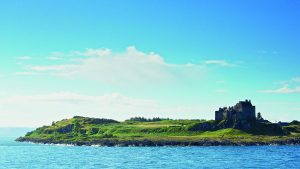
Maclean
Given as part of the dowry in the mid-14th century of Mary Macdonald, daughter of John of Islay, Lord of the Isles, Duart has been in and out of Maclean hands ever since.
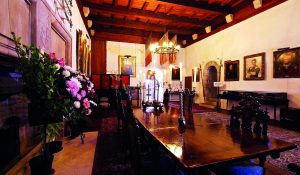
In ruin by the late 18th century and restored in the early 20th century, the castle commands a strategic position at the end of a north-facing peninsula on Mull and is one of Scotland’s last privately-owned clan castles. Visit the restored Banqueting Hall, the Edwardian state rooms, creepy dungeons, and ancient keep, visualising scenes from films such as When Eight Bells Toll with Sir Anthony Hopkins (1971) and Entrapment, starring Sean Connery and Catherine Zeta Jones (1999), as you go.
Castle Fraser
Inverurie, Aberdeenshire
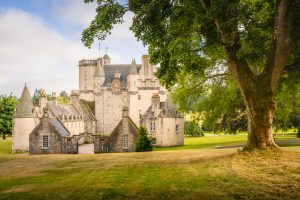
Mackenzie, Fraser, Pearson
This baronial five-storey tower house might be Scotland’s most romantic castle – there’s even the ghost of a murdered princess who haunts the Green Room, occasionally playing the piano.
There are turrets, secret trapdoors, hidden staircases, a spy hole, a wooden leg (see right), portraits, and a truly magnificent medieval stonevault Great Hall. Building work on the castle, originally called Muchall-in-Mar, began in 1575 under Michael Fraser, the 6th Laird, who had a taste for the elaborate, and was completed by 1636.
The castle was modernised in the late 18th century by the remarkable female laird, Elyza Fraser.
In the next century, Charles Fraser reconstructed the interiors, with architect John Smith’s Regency style trumping William Burn’s planned gothic extravagances, and new owners partially restored Castle Fraser around 1950.
This family home has Fraser collections, portraits, and many of the original contents, including furniture. It was the home of the Frasers of Muchalls, later Frasers of Castle Fraser, then the Lords Fraser, the Frasers of Inverallochy and then the family who took the name Mackenzie Fraser. In 1897 Frederick Mackenzie Fraser, the last male in the direct line, died childless, and in 1921 his widow Theodora sold the castle to industrialist, philanthropist, and Liberal MP Sir Weetman Pearson, 1st Viscount Cowdray, who used it as a shooting lodge.
nts.org.uk/visit/places/castle-fraser
Dunvegan Castle & Gardens
Isle of Skye
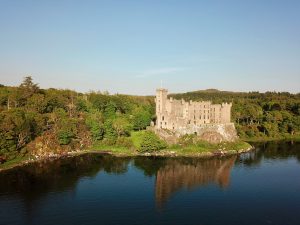
MacLeod
Dunvegan is the oldest continuously inhabited castle in Scotland and has been the home of the Chiefs of Clan MacLeod for 800 years.
The stunning lochside location, with its formal Water Garden and Walled Garden, and the grandeur of the many fine oil paintings and historic collections on display do nothing to detract from the feeling of this castle being a real family home, rather than a monument preserved in aspic.
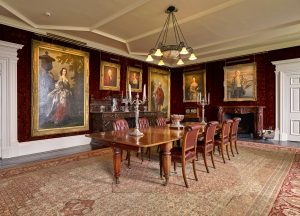
Among the many treasures at Dunvegan is the Fairy Flag – a sacred banner dating from between the 4th and 7th century that is said to bring Clan MacLeod victory in battle; and Sir Rory Mor’s Horn, which custom dictates that each new clan chief must drink a full measure from to prove his might.
Drummond Castle & Gardens
Crieff, Perthshire
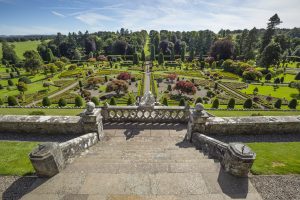
Drummond
Although the castle itself isn’t open to the public, Drummond undoubtedly has one of the nest gardens in all of Scotland, if not Europe. Check out the horticultural St Andrew’s Saltire, with a 17th-century multiplex sundial at the centre. The mile-long, beech-lined avenue is dotted with ancient yew hedges, as well as copper beech trees planted by Queen Victoria when she visited in 1842.
While here, Crieff is worth a visit – the ancient capital of Strathearn, this historic market town is home to the Glenturret Distillery (home of Famous Grouse whisky).
Brodie Castle
Forres, Moray
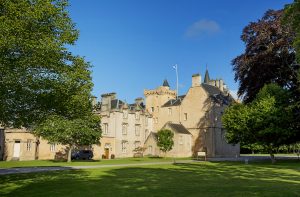
Brodie
Brodie Castle is a well-preserved Z-plan castle, erected in 1567 on land that possibly came into the hands of the Brodie family as a gift from King Malcolm IV around 1160.
Sadly, in 1645 the castle was set on re by Lewis Gordon, 3rd Marquess of Huntly, resulting in the destruction of the archives and historic documents related to the Brodies. It wasn’t until the mid-1800s that James Wylson rebuilt what was left into a turreted baronial-style mansion house.
Brodie Castle’s rich art collection includes several Dutch Old Masters, meanwhile if you visit the gardens at the right time of year, you can see the famous daffodil collection, which features more than 400 varieties.
nts.org.uk/visit/places/brodie-castle
Crathes Castle
Near Banchory, Aberdeenshire
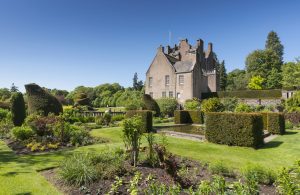
Burnett
The Burnetts of Leys built Crathes in the 16th century on land gifted to them by King Robert the Bruce in 1323 and owned it for almost 400 years.
The original timber-built crannog was replaced with the stone castle by Alexander Burnett of Leys in 1596. The castle was completed in the 18th century by a later Alexander Burnett, and subsequently substantially altered by Sir Robert Burnett in 1877.
Sir Robert Burnett installed oak panelling and other fake medieval trappings because his American wife, Matilda, felt that Crathes didn’t feel old enough. Many aspects of the original structure were revealed during works in 1913 and 1953, and a fire in 1966.
One of the best features of Crathes is the Jacobean rooms with original Scottish Renaissance painted ceilings, and much of the original carved furniture. The walled garden has Irish yew topiary hedges from 1702. Even older is the 50-metre-long row of 12 pits dug almost 10,000 years ago and believed to be the world’s oldest lunar calendar, twice the age of the previous record-holder in Mesopotamia, and in use for four millennia.
nts.org.uk/visit/places/crathes-castle
Fyvie Castle
Turriff, Aberdeenshire
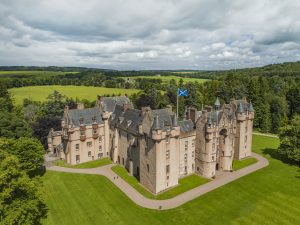
Preston, Meldrum, Seton, Gordon, Leith
A royal stronghold that began as a simple castle around 1214, towards the end of William the Lion’s reign, Fyvie Castle has also been the site of Robert the Bruce’s open-air court, and was Charles I’s childhood home. Each of the five important families who occupied Fyvie added a tower, steadily enhancing its grandeur as a Scottish baronial fortress – the Prestons (early 1400s), the Meldrums and Setons (1599, with the magnificent processional staircase added later), the Gordons (1778) and the Leiths (1890).
In 1644, Fyvie was the site of a battle between the Royalists James Graham, 1st Marquess of Montrose, and Manus O’Cahan, against the Covenanter army of Archibald Campbell, 8th Earl of Argyll and Chief of the Campbells.
As was conventional in Victorian times, Fyvie’s grounds and Loch Fyvie were landscaped in the 19th century. The Scottish Naval Officer and steel magnate Alexander Leith (later Forbes-Leith and 1st Baron Leith of Fyvie) bought the castle in 1885 and his descendants owned it until 1984.
Inside, the sumptuous interiors include a dramatic sweeping staircase, period furnishings, a collection of original arms and armour, portraits and other riches, and a hidden chamber off the charter room with a curse of death to the laird of the castle or his wife struck blind if anyone enters it.
Another curse, associated with the prophetic, poetic and somewhat fey Thomas the Rhymer, concerns three mysterious weeping stones, originally castle boundary markers. Like any decent castle of its provenance, Fyvie comes with a woman’s skeleton, two ghosts and an indelible blood stain.
nts.org.uk/visit/places/fyvie-castle
Kelburn Castle
Largs, Ayrshire
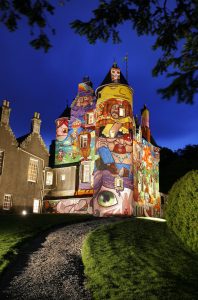
Boyle
Eye-popping” is the only suitable description of Kelburn, with its colourful graffiti mural on the exterior, although the inside is more conventional – plush and cultured.
Originally built in the 13th century, Kelburn was refashioned in the 16th century. In 1700, David Boyle, 1st Earl of Glasgow, made extensions to suggest a French château. Boyle was a supporter of the 1707 Acts of Union, and as the last
Treasurer-depute of Scotland, was keen to see its capital recover from the financial disaster of the Darien Scheme. Boyle’s capital recovered – more than 60 per cent of the compensation monies ended up with the Duke of Queensbury and Boyle, with Boyle also rewarded with six lordships in 1699, and a viscountcy and an earldom in 1703. In 2007 the 10th Earl, who sits in the House of Lords, invited four Brazilian artists to create the graffiti artwork outside and it’s since become a modern wonder, though not to everyone’s taste.
Kelburn doesn’t have stately grounds. Instead, there’s a forest with waterfalls, a sandstone grotto, Chinese garden, maze, witch’s cottage, giant’s castle, and a gingerbread house.
More traditional are its striking woodland glen trails and the breathtaking views across the Firth of the Clyde to Arran.
Doune Castle
Near Stirling
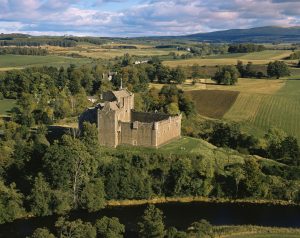
Stewart
Medieval stronghold Doune was somewhat dented during the Scottish Wars of Independence, before being rebuilt in its present form in the late 14th century by Robert Stewart, Duke of Albany, son of King Robert II of Scots, though it was forfeited to the Crown in 1425. Its position at ‘the crossroads of Scotland’ where the Ardoch Burn joins the River Teith between Stirling and Callander, commands the way from the Lowlands to the Highlands, something the Romans, who built fortifications here in the 1st century AD, were alert to.
Mary, Queen of Scots stayed at Doune several times, and the castle was held by forces loyal to her after 1567 but was yielded after a siege in 1570 to the 4th Earl of Lennox. Doune also saw action in the Wars of the Three Kingdoms, during Glencairn’s rising in the mid-17th century, and in the Jacobite risings between 1689 and 1745.
For a time it was a prison, but by 1800 the former royal castle was ruined. Fortunately, it was restored in the 1880s when George Stuart, 14th Earl of Moray, began repairs. Visitors may recognise Doune as the backdrop of 1952 film Ivanhoe, as Winterfell in Game of Thrones, and pretending to be various castles in Monty Python and the Holy Grail (1975).
historicenvironment.scot/visit-a-place/places/doune-castle
Caerlaverlock Castle
Glencaple, Dumfries
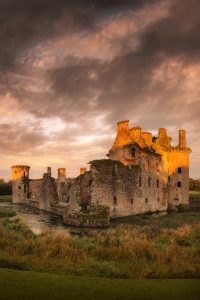
Maxwell
To understand medieval siege warfare and the siege engines used, visit Caerlaverock. To appreciate the history of centuries of cross-border warfare with England, visit Caerlaverock. To see a unique triangular-plan castle with a moat, battlements, towers, and an imposing gatehouse, visit Caerlaverock.
The Maxwell family built their formidable stronghold in the 13th century both for defence and to control trade. It was occupied until the 17th century, when the Maxwell Earls of Nithsdale built new accommodation within the battle-ravaged walls. Over that time, Caerlaverock withstood English sieges during the Wars of Scottish Independence, several cycles of damage and reconstruction throughout the 14th and 15th centuries, and finally attack by Covenanters in 1640.
It’s possible that Myrddin Wyllt, bard to King Gwenddoleu ap Ceidio, who died in battle nearby in the 6th century, was the inspiration for the wizard Merlin in Arthurian legend.
historicenvironment.scot/visit-a-place/places/caerlaverock-castle
Read more:
Scotland Magazine’s 12 Days of Christmas Advent Calendar Prize Giveaway

SCOTLAND MAGAZINE
Published six times a year, every issue of Scotland showcases its stunning landscapes and natural beauty, and delves deep into Scottish history. From mysterious clans and famous Scots (both past and present), to the hidden histories of the country’s greatest castles and houses, Scotland‘s pages brim with the soul and secrets of the country.
Scotland magazine captures the spirit of this wild and wonderful nation, explores its history and heritage and recommends great places to visit, so you feel at home here, wherever you are in the world.
